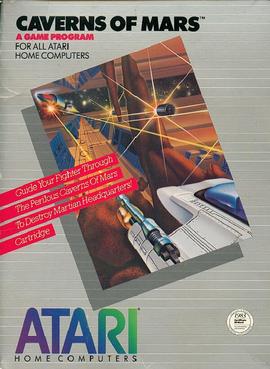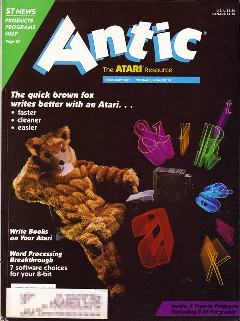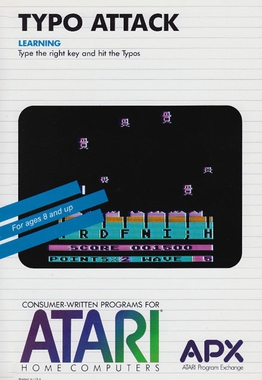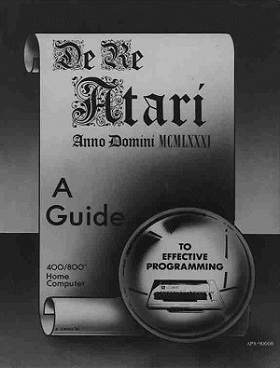
The Atari 8-bit computers, formally launched as the Atari Home Computer System, are a series of 8-bit home computers introduced by Atari, Inc. in 1979 with the Atari 400 and Atari 800. It is the first home computer architecture with coprocessors, enabling more advanced graphics and sound than most of its contemporaries. Video games are key to its software library, and the 1980 first-person space combat simulator Star Raiders is considered the platform's killer app.
Fueled by the previous year's release of the colorful and appealing Pac-Man, the audience for arcade video games in 1981 became much wider. Pac-Man influenced maze games began appearing in arcades and on home systems. Pac-Man was the highest grossing video game for the second year in a row. Nintendo's Donkey Kong defined the platform game genre, while Konami's Scramble established scrolling shooters. The lesser known Jump Bug combined the two concepts into both the first scrolling platform game and the first platform shooter. Other arcade hits released in 1981 include Defender, Frogger, and the Galaxian sequel Galaga.

Shamus is a shooter with light action-adventure game elements written by Cathryn Mataga and published by Synapse Software. The original Atari 8-bit computer version was released on disk and tape in 1982. According to Synapse co-founder Ihor Wolosenko, Shamus made the company famous by giving it a reputation for quality. "Funeral March of a Marionette", the theme song from Alfred Hitchcock Presents, plays on the title screen.

Eastern Front (1941) is a computer wargame for Atari 8-bit computers created by Chris Crawford and published through the Atari Program Exchange (APX) in 1981. A scenario editor and assembly language source code for the game were also sold by APX as separate products.

Caverns of Mars is a vertically scrolling shooter for Atari 8-bit computers. It was written by Greg Christensen, with some features later added by Richard Watts, and published by the Atari Program Exchange (APX) in 1981. Caverns of Mars became the best selling APX software of all-time and was moved into Atari, Inc.'s official product line, first on diskette, then on cartridge.

AtariWriter is a word processor program for the Atari 8-bit computers released by Atari, Inc. as a 16 kB ROM cartridge in 1983. The program was fast and easy to use, while still allowing for the creation of fairly complex documents. It was a success for the platform, with at least 800,000 units initially sold, not including international versions and later updates.

Antic was a print magazine devoted to Atari 8-bit computers and later the Atari ST. It was named after the ANTIC chip in the 8-bit line which, in concert with CTIA or GTIA, generates the display. The magazine was published by Antic Publishing from April 1982 until June/July 1990.Antic printed type-in programs, reviews, and tutorials, among other articles. Each issue contained one type-in game as "Game of the Month." In 1986, STart magazine was spun off to exclusively cover the Atari ST line.
Antic Software was a software company associated with Antic, a magazine for Atari 8-bit computers. Bound into issues of the magazine, the Antic Software catalog initially sold Atari 8-bit games, applications, and utilities from the recently defunct Atari Program Exchange. Original submissions were later added, as well as public domain collections, with all software provided on self-documented disk. When the Atari ST was released, it became a mixture of Atari 8-bit and Atari ST software and sold some major Atari ST titles such as CAD-3D. The magazine insert changed names several times, eventually being branded as The Catalog.

Typo Attack is an educational video game for Atari 8-bit computers designed to improve typing skill. It was written by David Buehler and published by the Atari Program Exchange in 1982. Buehler was seventeen years old when the game won the US$25,000 Atari Star Award for the best APX program of 1982. In 1984, Atari, Inc. moved Typo Attack into its official line as a cartridge.
Atari Program Exchange (APX) was a division of Atari, Inc. that sold software via mail-order for Atari 8-bit computers from 1981 until 1984. Quarterly APX catalogs were sent to all registered Atari 8-bit owners. APX encouraged any programmer, not just professionals, to submit video games, educational software, applications, and utilities. A few internally developed Atari products were sold through APX, such as Atari Pascal, the developer handbook De Re Atari, and a port of the arcade video game Kangaroo.

Many games, utilities, and educational programs were available for Atari 8-bit computers. Atari, Inc. was primarily the publisher following the launch of the Atari 400/800 in 1979, then increasingly by third parties. Atari also distributed "user written" software through the Atari Program Exchange from 1981 to 1984. After APX folded, many titles were picked up by Antic Software.

De Re Atari, subtitled A Guide to Effective Programming, is a book written by Atari, Inc. employees in 1981 and published by the Atari Program Exchange in 1982 as an unbound, shrink-wrapped set of three-holed punched pages. It was one of the few non-software products sold by APX. Targeted at developers, it documents the advanced features of the Atari 8-bit computers and includes ideas for how to use them in applications. The information in the book was not available in a single, collected source at the time of publication.

Dandy is a dungeon crawl maze video game for Atari 8-bit computers published by the Atari Program Exchange in 1983. It is one of the first video games with four-player, simultaneous cooperative play. Players equipped with bows and unlimited arrows fight through a maze containing monsters, monster spawners, keys, locked doors, food, and bombs in search of the exit leading to the next level. If a player dies, they can be revived by finding and shooting a heart. The game includes an editor for making new dungeons.

Wayout is a 3D first-person perspective video game programmed by Paul Allen Edelstein and published for the Atari 8-bit computers in 1982. It was released for the Apple II and Commodore 64 in 1983. Wayout is among the first maze games to offer full 360 degree 3D perspective and movement, and its graphics were considered state-of-the-art upon its release. There were many pseudo-3D maze games at the time, but they used a fixed perspective and limited the player to four orientations.

Preppie! is an action video game for Atari 8-bit computers published by Adventure International in 1982. It was programmed by Russ Wetmore of Star Systems Software, whose name is prominently displayed on the box cover. Leaning on the preppy trend of the early 1980s, the game follows prep schooler Wadsworth Overcash as he navigates the hazards of a country club to retrieve golf balls. Preppie! borrows heavily from Konami's Frogger, with lanes of traffic in the bottom half of the screen and a river crossing the top portion. Alligators are an element from both Frogger and preppy fashion; an open-mouthed gator is the icon of shirt brand Izod. Reviewers recognized the game as derivative, but called the music and visuals some of the best for Atari 8-bit computers.
Russ Wetmore is an American programmer and video game designer best known for writing commercial games and applications for Atari 8-bit computers in the early to mid 1980s. His Frogger-inspired Preppie! was published by Adventure International and praised by reviewers for the music and visuals. He also wrote the maze-game sequel, Preppie! II. Wetmore stopped writing games after the video game crash of 1983 and developed the integrated HomePak productivity suite for Batteries Included. He has remained in software development in director and architecture roles.

Drelbs is a maze video game written by Kelly Jones for Atari 8-bit computers and published by Synapse Software in 1983. An Apple II port by Jonathan Tifft was released the same year. A Commodore 64 version followed in 1984 implemented by Miriam Nathan and William Mandel. The objective is to move the walls of the maze to make boxes. Some reviewers found the overall collection of elements to be eccentric and unique.

Star Maze is a space-themed shooter taking place in a multidirectional scrolling maze published by Sir-Tech in 1982. It was written by Canadian programmer Gordon Eastman for the Apple II, based on a design by Robert Woodhead. Versions for the Atari 8-bit computers and Commodore 64 followed in 1983.

Kid Grid is a grid capture game which borrows heavily from the 1981 arcade video game Amidar. Written by Arti Haroutunian for Atari 8-bit computers, it was published by Tronix in 1982. A Commodore 64 port from the same programmer was released in 1983. In Kid Grid, the player moves along the horizontal and vertical lines of the playfield, turning the lines from dotted gray to solid blue. If all the lines around a square are completed, it is filled-in. Deadly creatures chase the player.
















